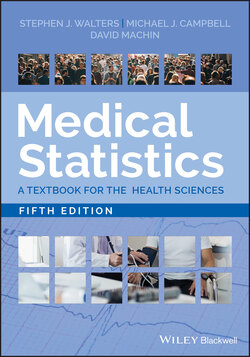Читать книгу Medical Statistics - David Machin - Страница 81
Example – Summarising Results from a Clinical Trial – Corn Plasters RCT: Differences in Proportions
ОглавлениеTable 3.4 shows the results of a randomised controlled trial conducted by Farndon et al. (2013) to investigate the effectiveness of salicylic acid plasters compared with usual scalpel debridement for treatment of foot corns. There are two study groups, the control group (randomised to receive usual care of scalpel treatment) and the experimental or intervention group (randomised to receive corn plasters). The main outcome measure was whether or not the index corn had improved or resolved (healed) at a three‐month post‐randomisation as assessed by an independent podiatrist ‘blind’ to the treatment group.
Table 3.4 Corn healing rates at three‐months post‐randomisation in patients with corns by randomised treatment group
(Source: data from Farndon et al. 2013).
| Index corn resolved/healed at a three‐month post‐randomisation | Corn plaster (intervention) group | Scalpel (control) group | ||
|---|---|---|---|---|
| n | (%) | n | (%) | |
| Yes | 32 (a) | (34%) | 20 (b) | (21%) |
| No | 63 (c) | (66%) | 74 (d) | (79%) |
| Total | 95 (a + c) | (100%) | 94 (b + d) | (100%) |
The ‘risk’ or proportion of patients whose corn was healed or resolved by a three‐month post‐randomisation is 32/95 = 0.337 or 34% in the plaster group and 20/94 = 0.213 or 21% in the scalpel group. The difference in proportions or RD is 0.337–0.213 = 0.124 or 12%. If we started with 100 patients in each arm we would expect 12 more patients' corns to have healed in the plaster arm compared to the scalpel arm by the three‐month follow‐up.
